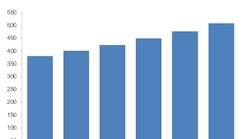Source: Flow Research
The vortex flowmeter market for eight worldwide regions is expected to grow at a 6.0% compound annual growth rate (CAGR) from $380 million in 2022 to just over $508 million in 2027, according to a new study, The World Market for Vortex Flowmeters, 7th edition, by Flow Research. The report adds that China has the greatest revenue share at 26.1% of the worldwide total, followed by North America and Western Europe, while China and the Asia/Pacific regions are expected to experience the fastest growth.
Flow Research reports the versatility, reliability and accuracy at economical prices continue to drive the steady market growth of vortex flowmeters. It adds the largest application for vortex flowmeters worldwide is in non-custody transfer of steam, which is difficult to measure due to its two-phase characteristics, and typically high temperatures and pressures. It’s so difficult that neither Coriolis nor ultrasonic technologies made significant inroads into measuring steam, and magnetic technologies are essentially excluded. Vortex flowmeters are technically well-suited for measuring gas and steam flows, and their use keeps pace with industry growth, and contributes to their market growth.. They also provide wide rangeability that allows steam flow measurement at varying velocities in different points along the manufacturing cycle.
Multivariable vortex meters were first introduced in 1997 through a joint venture with VorTek and Sierra Instruments. Since then, other suppliers introduced multivariable vortex flowmeters, which now account for nearly 24% of total vortex flowmeter revenues.
A limitation of vortex flowmeter measurement has been its performance in low-flow conditions. Its basic operation immerses a shedder bar in the flow stream to generate swirling vortices downstream, which are measured to determine actual, volumetric flowrates. Low-flow conditions lack the fluid velocity to create the required vortices. However, several manufacturers now offer models with reduced bores at the measurement point, which enable vortex flowmeters to more effectively and accurately measure low flows. In addition, installation costs are typically lower than for standard bore meters, which have more upstream/downstream straight-pipe length requirements.
Both single-line size and double-line size reduced bore vortex flowmeters have become increasingly popular and revenues from these types are projected to continue to grow through 2027.
In response to demand for increased reliability, manufacturers have introduced two redundant vortex meter configurations. They include a single shedder bar with dual sensors, and dual-vortex meters calibrated and installed in tandem directly in the flow stream. Both ensure a higher degree of measurement certainty and reliability. Though the traditional installation with a single shedder bar and sensor still dominates the market, Flow Research’s new study determined that users see the value of measurement redundancy, and that suppliers can achieve higher growth rates by promoting the dual configurations.
“The vortex flowmeter market is strong and positioned for growth, especially in gas flow measurement. Vortex flowmeters are versatile, accurate, and economical; many vortex meters offer accuracy readings of better than 1%, depending on the fluid and application,” says Jesse Yoder, president of Flow Research. “They can measure liquid, gas, and steam flow with equal ease. They’re widely used for steam flow measurement, and can handle the high temperatures of superheated steam. They also have very favorable costs of acquisition, commissioning and ownership. These factors make vortex meters attractive to industrial companies striving to trim energy and other expenses, explore energy usage as a cost center, and ensure compliance with International Organization for Standardization (ISO) standards.”





